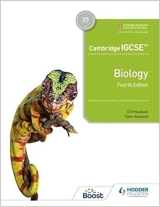Chapter 8. Reproduction in flowering plants
Page 69
1. Calyx, petals, stamens, carpels.
2. Colour, scent, nectar.
3. a Ovule
b Ovary.
Page 71
1. e anthers split. d bee visits young flower. a dusted with pollen. c bee visits older flower.
b pollen deposited on stigma.
2. Apple, cherry, horse chestnut (They all have flowers with conspicuous petals).
3. a Only a large insect, such as a bee, can push between the upper and lower petals to reach the nectary.
b The nectaries are at the end of a long spur. Only insects with long ‘tongues’ can reach them.
4. There seems no reason why insects should not also become adapted to pollination of certain flowers. You might expect the adaptations to include the development of longer mouthparts which reach distant nectaries, a bristly thorax to which pollen can stick, increased sensitivity to specific colours and scents, more acute vision.
5.
| Insect pollinated |
Wind pollinated |
White or coloured petals.
Scented.
Nectar produced.
Stamens and stigma wholly or partly protected or concealed by petals.
Spiky pollen grains* |
Small green petals.
Not scented.
No nectar.
Stamens and stigma exposed to the air.
Light, smooth pollen grains. |
*Not described in the text
Page 72
1. a The stamens.
b The ovaries.
2. Pollination is the transfer of pollen from the anthers to the stigma.
Fertilisation is the fusion of male gametes from the pollen with the female gametes in the ovule.
3. a Yes.
b No.
4. a The ovary forms the fruit.
b The petals, the stamens, the stigma and style fall off after fertilisation.
c The calyx remains attached.
5. a Fruits. Runner beans, grapes, marrows, tomatoes.
b Seeds. Peas. baked beans.
c Neither. Rhubarb.
Page 74
1. The advantages of dispersal are (a) that the seedlings are less likely to compete with each other if the seeds are widely dispersed, (b) that new areas may be colonised. The disadvantage is that a large proportion of seeds may land in situations where they cannot grow.
2. Seeds light enough to be carried on the wind are likely to be carried long distances before they fall to the ground. Seeds carried by animals are likely to be carried long distances depending on the normal range of the animal. Birds are likely to carry the seeds for the greatest distances.
3. Wind pollination refers to the transport in the air of pollen grains produced by the stamens of one plant to the stigma of another flower of the same species. Although the pollen grains may be carried anywhere, pollination does not occur unless the pollen reaches the stigma. Wind dispersal involves the random distribution of a plant’s seeds in air currents until they fall to the ground where they may germinate.
Page 76
1. a The function of the radicle is to produce a root which will anchor the plant in the soil and absorb water and minerals.
b The function of the plumule is to a produce a shoot with a stem and leaves which will make food by photosynthesis.
c The function of the cotyledons is to provide food for the germinating seedlings. In some cases, the cotyledons protect the plumule as it grows through the soil.
2. This question is erroneous. The book deals with the French bean and not the broad bean. In the case of the French bean, a the plumule is protected by being enclosed between the cotyledons during its passage through the soil. b The radicle is protected by the root cap.
3. The seedling will use the stored food to provide energy from respiration to drive all the processes involved in germination. The food provides the raw materials (proteins, carbohydrates. lipids), for construction of new cytoplasm, new cells and new tissues, i.e. growth.
4. Once the first leaves appear in the seedling and start to produce food by photosynthesis, the seedling will become less and less dependent on the stored food.
5. The radicle will start to absorb water from the soil. Until the plumule has a supply of water to expand the cells, (by osmosis), it cannot extend and grow.
Page 77
1. Water, oxygen and a suitable temperature.
2. The question should read ‘…experiments 2-4….’
In Experiment 4, light was excluded from all the seeds but only the ones in the refrigerator failed to germinate properly. Light, therefore, was not necessary for germination.
3. This should refer to Experiment 4
a Remove the seeds from the refrigerator and leave them at room temperature. If they have not been ‘killed’ by the low temperature, they should begin to germinate.
b In theory, you could set up controlled environments in which the temperatures ranged from 0 - 15 degrees centigrade. You would have to decide how long to leave the seeds before interpreting the results.
Page 78
1. Warm, moist, well aerated soil. By digging the soil, aeration and drainage are improved. The seeds must be kept watered. |
Downloads
Download the answers in PDF format below
Section 1, Chapters 1-5
Section 2, Chapters 6-9
Section 3, Chapters 10-12
Section 3, Chapters 13-17
Section 3, Chapters 18-20
Section 4, Chapters 21-24
Section 5, Chapters 25-27
Section 5, Chapters 28-29
Section 6, Chapters 30-34
Section 6, Chapters 35-37
Section 7, Chapters 38-39
Section 8, Chapters 40-41
|
